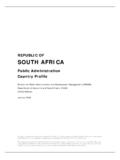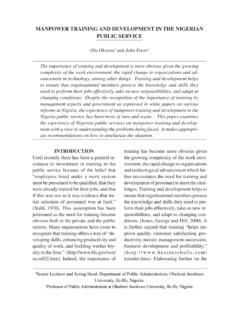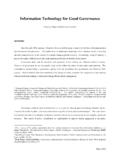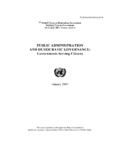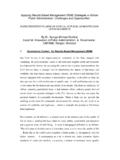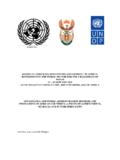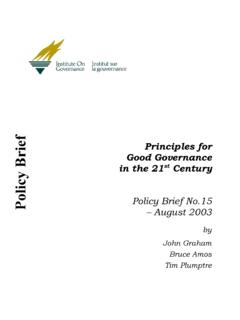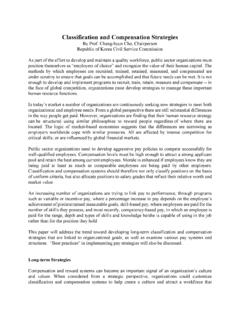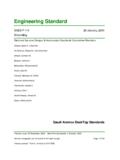Transcription of Fugitive Emission Monitoring Program Study At Shedgum …
1 401 Fugitive Emission Monitoring Program Study At Shedgum Gas Plant, saudi aramco Jaber B AL-Muaibid, Sr. Process & Environ. Engineer, saudi aramco , Email: Ahmed S AL-Ayadhi, Process Engineer, saudi aramco , 402 ABSTRACT A Fugitive Emission survey Study was successfully conducted on a sample of about 2000 components at Shedgum Gas Plant in saudi aramco for environmental and economical purposes. The Study involved Monitoring of up to 2000 components of flanges, valve packing, pump seals and others for Fugitive emissions leaks and documenting the details of the sample in customized software. The survey included the implementation of process research, flagging, tagging, documentation, Monitoring , repair attempts and report generation.
2 About of the surveyed component was found badly leaking. In light of the recent promulgated global General Environmental Regulations, saudi aramco has realized that such survey has become increasingly important to conduct this survey in all its oil and gas facilities. The Study benefits are to reduce Fugitive Emission at the company oil & gas plants and recover more valuable product that otherwise will be lost, improve ambient air quality and reduce the contribution to the formation of ozone. INTRODUCTION Fugitive emissions are those emissions entering into the atmosphere that are not released through a stack, vent , duct pipes, storage tank or other confined air stream. These emissions include equipment leaks and area emissions . In individual cases, Fugitive emissions may be sufficient to cause violations of ambient air quality standards even after implementation of source controls.
3 Thus all the precautions should be taken to prevent any Fugitive emissions going beyond boundaries of facility. It is very difficult and expensive to estimate such emissions . Thus it is advisable to calculate 403the Fugitive emissions with the help of data available from direct measurement. Although the Fugitive emissions were known to the regulatory agencies, no estimate or standard was developed until early 80 s. The EPA began to develop a series of National Emission standards for Hazardous Air Pollutants (NESHAPs) which established standards for industries, NEDHAP includes the Leak Detection and Repair (LDAR) Program to detect, estimate and reduce Fugitive Emission . The facilities are required to estimate Fugitive Emission every six months to determine the facility s compliance with operating permits according to the Clean Air Act Amendment (CAAA) of 1990.
4 For this survey, Fugitive emissions of volatile organic compounds (VOC) are monitored according to method 21 of the US Environmental Protection Agency (EPA). A VOC analyzer (flame ionization and/or photo ionization detector) is used to monitor process leaks. The data collection unit consists of a detection probe, a data logger to store measurement results, and a software interface to communicate with the central PC. The analyzer is explosion proof to insure safe operation within oil & gas plants and petrochemical environment. This Study has been conducted in Shedgum Gas Plant, saudi aramco , which processes natural gas to produce sale gas, sulfur and NGL. 404 SOURCES OF Fugitive emissions The following are the general sources of Fugitive emissions . Process Equipment Leaks such as valves, flanges, seals, sample connections, open ended line, pressure relief devices and screwed fittings.
5 Loading and uploading losses Evaporation from spills and retention ponds 405 Un-captured process emissions Waste treatment facilities Fugitive emissions are classified into two major categories of chemicals; Volatile Organic Compound and Hazardous Air Pollutants. Volatile Organic Compounds: Volatile Organic Compounds or VOCs are organic chemicals that easily vaporize at room temperature. They are called organic because they contain the element carbon in their molecular structures. VOCs have no color, smell, or taste. VOCs include a very wide range of individual substances, such as hydrocarbons (for example benzene and toluene), halocarbons and oxygenates. The need for VOC detection plays an important task in combating the pollution problem arising out of Leaking components.
6 The Program for VOC detection is popularly known as Leak Detection And Repair System (LDRS) or Fugitive Emission Monitoring Program . Hazardous Air Pollutants: Hazardous Air Pollutants (HAPs) are mainly toxic and more hazardous chemicals than VOCs. LEAK DEFINITION The regulatory authority in Kingdom of saudi Arabia combined Fugitive emissions Monitoring for both HAPs and VOCs in a single regulation; however the leak definition for HAP (>500) was set lower than the leak definition for VOC (>10,000 ppm). The regulation applied to components such as valves, pressure relief devices, pumps and compressors in either HAP or VOC services; it also applies to flanges in HAP service. 406 Study EXECUTION METHODOLOGY The Study Program selected sample components and covered certain area in the Shedgum Gas Plant, saudi aramco .
7 The areas that had been surveyed were Khuff Gas Processing Facilities, Hydrocarbon Condensate Stripping System, Gas Treating Units and NGL Recovery. The implementation methodologies were as follows: Process Research: Process research covers review of stream compositions from PFD S & P&ID S to determine applicability and the service (liquid or vapor) of the steam. Flagging: Flagging covers identification and verification of components in the field Tagging: Tagging includes fixing of bar coded and numbered tags to each component that was Identified during the flagging. Documenting: Documenting covers populating the database for all selected components by using hand hold mini computer to enter data about location, BCT #, drawing #, HAP or VOC type & product code. 407 Monitoring : Monitoring includes; Monitoring all selected components by instrument detector in PPM concentration of leaking gas, utilizing TVA-1000 (Thermo Environmental Instrument).
8 Repair Attempts: Repair attempts to avoid minor Leaking during survey then re- Monitoring to have accurate results. Report Generation: Reporting which includes generating a report of all leaking components in LEADERs Software which is for leak detection and repair software for implementation of Fugitive emissions Monitoring and modeling Program . Study EQUIPMENT UTILIZATION The Study utilized the following equipment and software to perform the daily routine Monitoring and documentation: Thermo Environmental TVA 1000B portable Toxic Vapor Analyzer flame ionization detector (FID). DAP Technology PC 9800 LS handheld computer configured with bar code scanner. The LEADERS LDRS Software System . The EPA Method 21 standards 408 Study BENEFITS Successful implementation of a comprehensive Fugitive emissions Monitoring Program would enable the production facility to achieve the following noteworthy benefits: Increase revenue to the facility through the reduction in the loss of valuable, saleable products.
9 Reduced fire risk to the entire facility and neighboring plants. Significant contribution to the improvement of air quality in the immediate environs of the plant as well as to the residential community in the industrial city. Significantly contribute to the reduction of the ground level ozone which is hazardous to human health. Help to sustain industrial productivity at its peak while successfully reducing the emissions of hazardous air pollutants to the atmosphere. Improves a maintenance routine Helps to comply with the environmental laws. Study RESULTS Based on the Monitoring results shown in the table & graph below, figure # 1 & 2 the estimation of Emission quantity has been calculated using the EPA emissions factors and based on the Integrated Method for Petroleum Process Units with 10,000 ppm PEGGED Emission Rate.
10 The Study showed that 153 components ( ) were leaking out of the 2016 components monitored. The extent of VOC Emission from these leaking components is higher than what has been expected at Shedgum Gas Plant. 409 Figure # 1: Monitoring Results. Unit Total MonitoredFound Leaking Percent LeakingM25 khuff gas process facilities 596 40 R40-condensate stripping Shedgum ngl center 404 38 R41-gas treating ngl center 282 27 R42- ngl recovery 734 48 Total for all the units 2,016 153 Figure # 2: Emission Summary STDSM25R40R41R42 LEAK % 410 Plan Of Action The Study concluded the following action plan to enhance the Emission condition at Shedgum Gas Plant: Monitor all accessible components every six month and the inaccessible ones every year.
